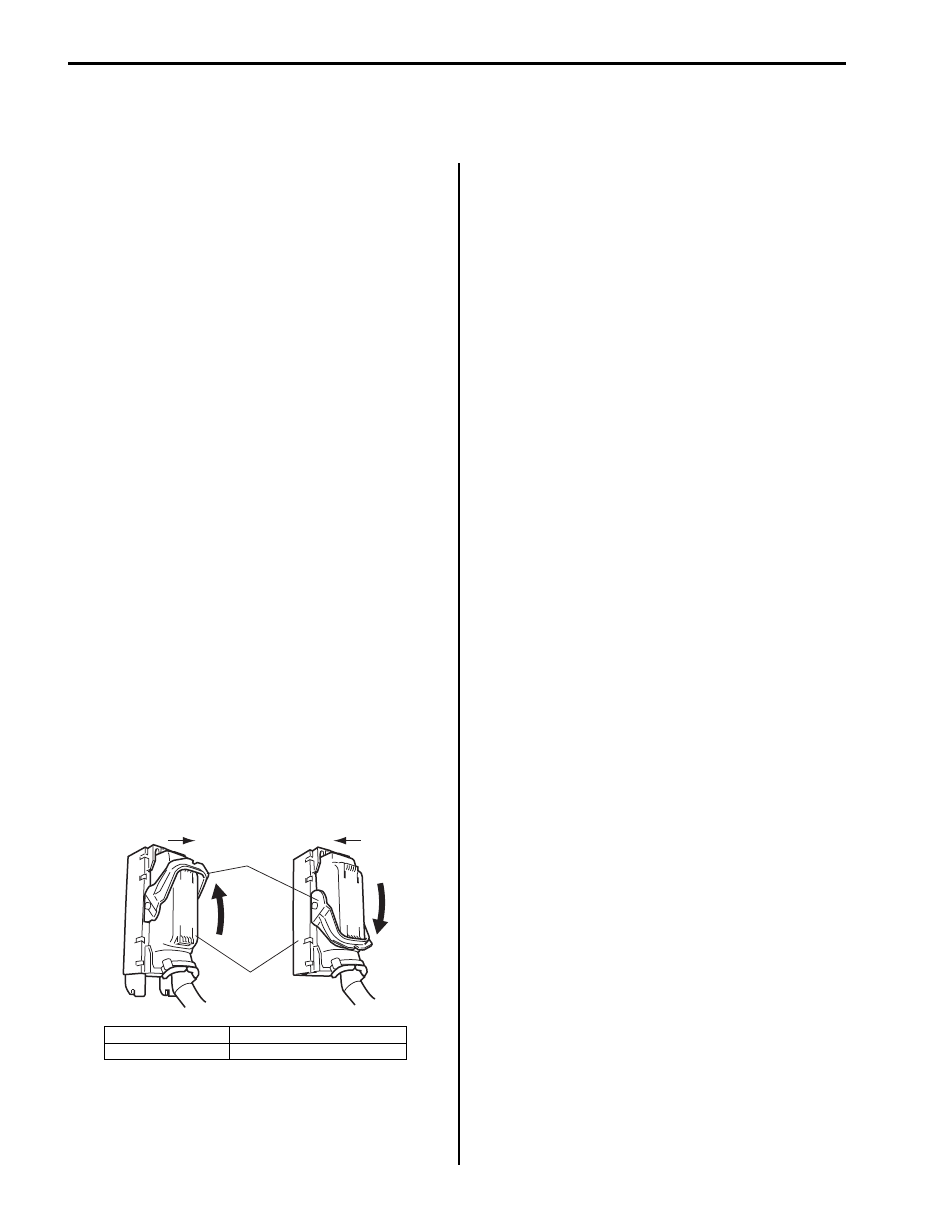Suzuki Grand Vitara JB627. Service manual — part 190

4E-41 ABS:
Rear Wheel Speed Sensor Inspection
S6JB0B4506010
Refer to “Front Wheel Speed Sensor Inspection” since
rear wheel speed sensor is the same as front wheel
speed sensor.
Front Wheel Encoder On-Vehicle Inspection
S6JB0B4506011
Before inspect front wheel encoder, remove front drive
shaft referring to “Front Drive Shaft Assembly Removal
and Installation: Front in Section 3A”.
• Check encoder (1) for being crack, damaged or
deformed.
• Turn wheel and check if encoder rotation is free from
eccentricity and looseness.
• Check that no foreign material is attached.
If any faulty is found, repair or replace. Refer to “Front
Wheel Hub Assembly Removal and Installation in
Section 2B”.
Front Wheel Encoder Removal and Installation
S6JB0B4506012
CAUTION
!
Front wheel encoder is included in front
wheel hub assembly. If front wheel encoder
needs to replaced, replace it as a front wheel
hub assembly.
For removal and installation of front wheel hub
assembly, referring to “Front Wheel Hub Assembly
Removal and Installation in Section 2B”.
Rear Wheel Encoder On-Vehicle Inspection
S6JB0B4506013
Before inspect rear wheel encoder, remove rear drive
shaft referring to “Rear Drive Shaft Assembly Removal
and Installation: Rear in Section 3A”.
• Check encoder (1) for being crack, damaged or
deformed.
• Turn wheel and check if encoder rotation is free from
eccentricity and looseness.
• Check that no foreign material is attached.
If any faulty is found, repair or replace. Refer to “Rear
Wheel Hub Assembly Removal and Installation in
Section 2C”.
Rear Wheel Encoder Removal and Installation
S6JB0B4506014
CAUTION
!
Rear wheel encoder is included in rear wheel
hub assembly. If rear wheel encoder needs to
replaced, replace it as a rear wheel hub
assembly.
For removal and installation of front wheel hub
assembly, referring to “Rear Wheel Hub Assembly
Removal and Installation in Section 2C”.
1
I5JB0A450034-01
1
I5JB0A450035-01

ABS: 4E-42
Specifications
Tightening Torque Specifications
S6JB0B4507001
NOTE
The specified tightening torque is also described in the following.
“ABS (ESP
®) hydraulic unit / control module Assembly Components”
Reference:
For the tightening torque of fastener not specified in this section, refer to “Fastener Information in Section 0A”.
Special Tools and Equipment
Special Tool
S6JB0B4508001
Fastening part
Tightening torque
Note
N
⋅m
kgf-m
lb-ft
Brake pipe flare nut (M10)
16
1.6
11.5
Brake pipe flare nut (M12)
19
1.9
14.0
ABS (ESP
®) hydraulic unit / control module
assembly bolt
9
0.9
6.5
ABS (ESP
®) hydraulic unit / control module
assembly bracket bolt
25
2.5 18.0
ABS (ESP
®) hydraulic unit / control module
assembly bracket nut
25
2.5 18.0
Front wheel speed sensor bolt
11
1.1
8.0
Front wheel speed sensor harness clamp bolt
11
1.1
8.0
Rear wheel speed sensor bolt
11
1.1
8.0
Rear wheel speed sensor harness clamp bolt
11
1.1
8.0
09950–78220
SUZUKI scan tool
Flare nut wrench (10 mm)
—
This kit includes following
items. 1. Tech 2, 2. PCMCIA
card, 3. DLC cable, 4. SAE
16/19 adapter, 5. Cigarette
cable, 6. DLC loop back
adapter, 7. Battery power
cable, 8. RS232 cable, 9.
RS232 adapter, 10. RS232
loop back connector, 11.
Storage case, 12. ) / )

4F-1 Electronic Stability Program:
Brakes
Electronic Stability Program
Precautions
Precautions in Diagnosing Troubles
S6JB0B4600001
To ensure that the trouble diagnosis is done accurately
and smoothly, observe the following and follow
“Electronic Stability Program Check”.
• Diagnostic information stored in ESP
® control module
memory can be cleared as well as checked by using
SUZUKI scan tool. Before using scan tool, read its
Operator’s (Instruction) Manual carefully to have good
understanding as to what functions are available and
how to use it.
• If the vehicles was operated in any of the following
ways, ESP
® warning light may light momentarily but
this does not indicate anything abnormal in ESP
®.
– The vehicle was driven with parking brake pulled.
– The vehicle was driven with brake dragging.
– The vehicle was stuck in mud, sand, etc.
– Wheel spin occurred while driving.
– Wheel(s) was rotated while the vehicle was jacked
up.
• Be sure to read “Precaution for CAN Communication
System in Section 00” before inspection and observe
what is written there.
• Be sure to use the trouble diagnosis procedure as
described in “Electronic Stability Program Check”.
Failure to follow it may result in incorrect diagnosis.
(Some other diagnosis trouble code may be stored by
mistake in the memory of ESP
® control module
during inspection.)
• When disconnecting ESP
® control module connector
(1), pull up lock lever (2) of connector.
When connecting, set the connector on ESP
®
hydraulic unit / control module assembly and pull
down the lock lever (2) until it locks.
• Communication of ECM, TCM (A/T model), BCM,
ESP
® (ABS) control module (if equipped), 4WD
control module (if equipped), keyless start control
module (if equipped) and combination meter is
established by CAN (Controller Area Network).
Therefore, be sure to read “Precaution for CAN
Communication System in Section 00” before
inspection and handling CAN communication line.
Precautions in On-Vehicle Service
S6JB0B4600002
When connector is connected to ESP
® hydraulic unit /
control module assembly, do not disconnect connectors
of sensors with ignition switch ON. Otherwise, DTC will
be set in ESP
® control module.
Precautions in Hydraulic Unit Operation Check
S6JB0B4600003
ESP
® hydraulic unit / control module assembly function
is checked by correct wheel lock / release condition
when brake pressure is pressurized / depressurized
using SUZUKI scan tool. The hydraulic unit operation
check referring to “Hydraulic Unit Operation Check in
Section 4E” should be performed to confirm the correct
brake pipe connection in the following cases.
• ESP
® hydraulic unit / control module assembly was
replaced.
• Brake pipe and/or hose were replaced.
[A]: Disconnect
C: Pull up to disconnect
[B]: Connect
D: Pull down to connect
2
1
[A]
[B]
C
D
I6JB01460001-01

Electronic Stability Program: 4F-2
Precautions in Sensor Calibration
S6JB0B4600004
ESP
® control module stores calibration points data of yaw rate / G sensor assembly and master cylinder pressure
sensor. Steering angle sensor stores calibration point data of itself.
TCS and stability control system use these sets of data.
When the following operation is done, calibration should be performed since the original calibration points are deleted.
Perform sensor calibration according to “Sensor Calibration”.
Precautions in Speedometer Test or Other Tests
S6JB0B4600005
When performing speedometer or a bench test while rotating a tire, ESP
® function must be kept at stop. It is possible
to stop ESP
® function temporarily by ESP® OFF switch. In this case, however, the function is forced to come back to
work when the speed exceeds 30km/h (18.5 mph) and may hinder accurate testing.
There are two ways to stop the ESP
® function completely as described bellow.
• Connect the SUZUKI scan tool, set to the “MISC. TEST” mode to stop the ESP
® function. Refer to SUZUKI scan
tool operator’s manual for further details.
• Disconnect the connector of the steering angle sensor, and ESP
® function is forced to enter the fail-safe mode,
then ESP
® function is stopped.
However, when this method is used, DTC remains in the memory of the ESP
® control module. Therefore, after the
test, re-connect the connector, clear DTC in the memory of the ESP
® control module. And calibrate steering angle
sensor referring to “Sensor Calibration”.
General Description
Electronic Stability Program Description
S6JB0B4601001
Electronic Stability Program (ESP
®) main function is to control ABS / EBD, TCS and stability.
• ABS / EBD
ABS function is that four wheel brake forces are independently varied with referring each wheel slip condition.
EBD function is that front and rear wheel braking forces are varied with referring loading distribution of the vehicle.
ABS improves the vehicle stability, controllability and braking performance.
For the details, refer to “ABS Description in Section 4E”.
• TCS (Traction Control System)
TCS function is that engine torque is controlled and brake is applied with referring wheel spin condition during
vehicle starting and accelerating.
• Stability control system
Stability control system is that engine torque is controlled and brake is applied with referring vehicle condition (over
steering, under steering) during cornering.
ESP
® is a registered trademark of Daimler Chrysler AG.
Sensor
Procedures required calibration
Steering angle sensor
• Power is not supplied to steering angle sensor. (battery and/or fuse is removed.)
• Steering angle sensor is replaced.
• Power is not supplied to ESP
® control module. (battery, fuse and/or connector is
removed.)
• ESP
® hydraulic unit / control module assembly is replaced.
Master cylinder pressure sensor • ESP
® hydraulic unit / control module assembly is removed or replaced.
Yaw rate / G sensor assembly
• Yaw rate / G sensor assembly is removed or replaced.
• ESP
® hydraulic unit / control module assembly is replaced.

Нет комментариевНе стесняйтесь поделиться с нами вашим ценным мнением.
Текст